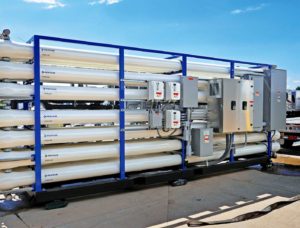Problem
An Ohio automotive manufacturer suffered a system crash of its ion-exchange equipment that resulted i n an inability to produce high-quality water. The aging equipment caused additional problems including the daily transfer of hazardous chemicals. The nearest service tech was located i n another state and could not get to the site for a couple of days, so MPW stepped in.
Solution
MPW’s specialized teams united to create a comprehensive, cost-effective solution. MPW installed a water-treatment system that includes two 30-cubic-foot carbon vessels with a sodium bisulfite feed for chlorine removal and a 50 gallon per minute (gpm) single pass reverse osmosis (RO) skid system. This integrated system was necessary in order to meet the customer’s quality and quantity specifications for the treatment of municipal water. A service contract for weekly to bi-monthly service to increase reliability was included.
The RO is equipped with tank-level controls that automatically activate the system when the permeate inside the tank reaches a low level, or shuts down the system when the permeate reaches elevated levels. This automation decreases the amount of human interaction required, which in turn allows site personnel to perform other tasks.
Results
MPW proved its value to the manufacturer by creating improved water quality and reliability and competitively priced equipment and lease terms. Additionally, MPW maintains six service centers strategically located across North America should another emergency arise.
With the RO system, MPW significantly diminished hazardous chemicals, such as caustic and sulfuric acid, which were used to regenerate the previous ion-exchange equipment. There were no safety incidents during this project.
MPW passed along cost savings as a result of the use of newer equipment with 24-hour, 365-day support and service to maintain the RO system. With those options the client is free to focus on its core functions, and is confident it will not face another potentially hazardous downtime incident.
